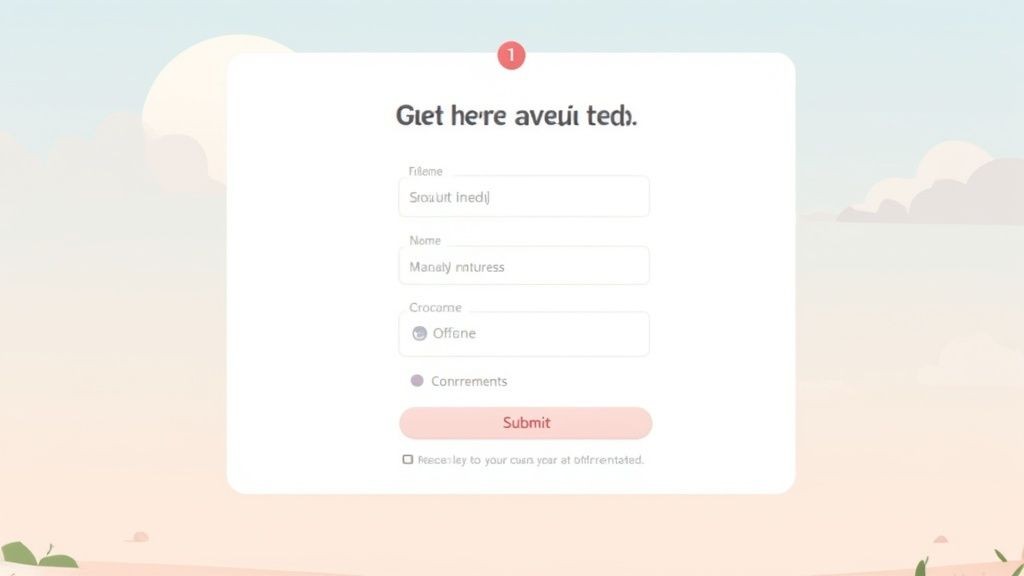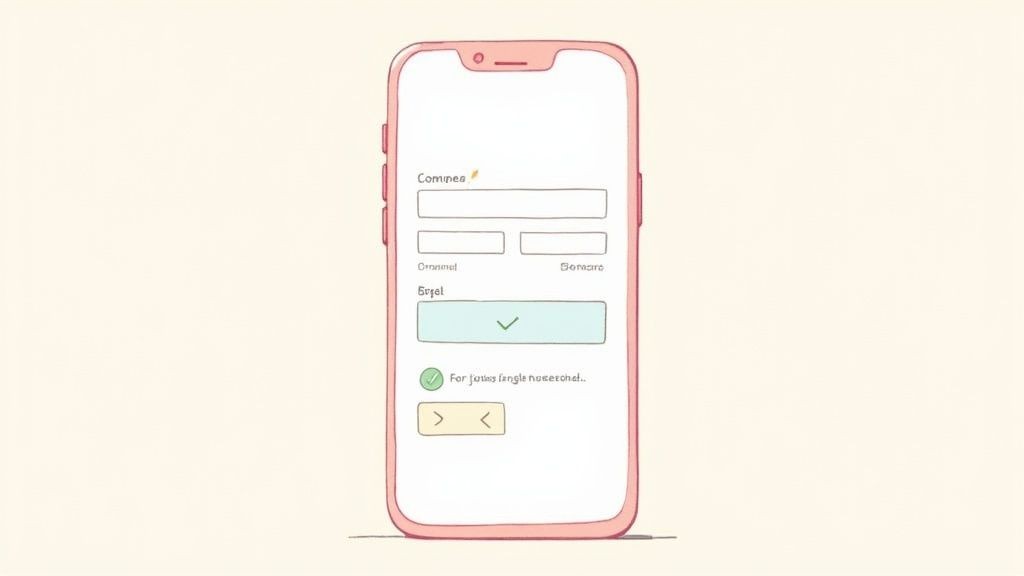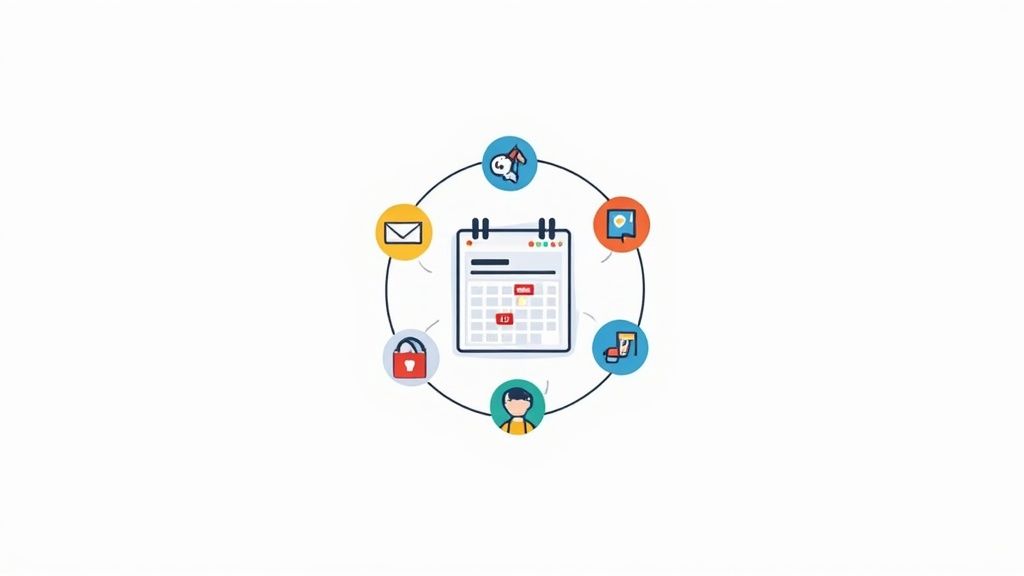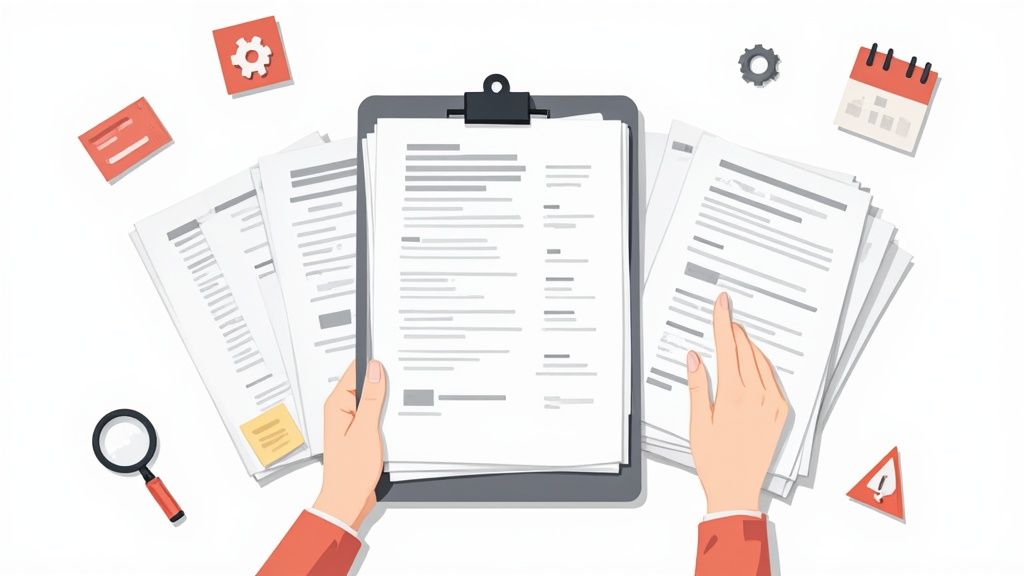A seamless registration process is the critical first step to a successful event. It's more than just collecting names; it's about creating an effortless and engaging experience that converts interest into attendance. A clunky, confusing, or overly demanding form can be the single point of failure that turns away dozens, if not hundreds, of potential attendees before they even have a chance to engage with your brand.
This guide moves beyond generic advice to deliver actionable event registration best practices. We will explore eight essential strategies, from simplifying forms for mobile-first users to leveraging sophisticated automation and data analytics. You'll learn how to implement early bird pricing that creates urgency, integrate social sharing to expand your reach, and provide automated communications that keep registrants informed and excited. Each tactic is designed to help you reduce friction, build anticipation, and ultimately, maximize attendance.
Prepare to transform your registration process from a simple administrative task into a powerful marketing tool. These proven methods will help you set the stage for an unforgettable event, ensuring your efforts translate directly into filled seats and engaged participants. Let's dive in.
1. Simplify the Registration Process
The single most impactful event registration best practice is to make the process as simple and frictionless as possible. Every extra field, click, or page you add increases the likelihood of a potential attendee abandoning the process. The goal is to get attendees from "I'm interested" to "I'm registered" with minimal effort. A complicated or lengthy form signals that the event itself might be disorganized, creating a poor first impression.

This approach focuses on a user-centric design that respects the attendee's time. For example, Eventbrite often uses a single-page registration for simple events, while conferences like Google I/O streamline their developer sign-ups by only asking for essential information upfront. This core principle helps maximize conversions by removing barriers.
How to Implement a Simplified Process
To put this into practice, critically evaluate every piece of information you ask for. Is it a "need to have" for event logistics or a "nice to have" for marketing?
- Eliminate Unnecessary Fields: Do you really need their job title, company size, and phone number for a free webinar? Probably not. Cut any field that isn't absolutely essential for registration.
- Use Social Logins: Allow users to register with one click using their Google, LinkedIn, or Facebook accounts. This auto-fills their name and email, saving significant time.
- Implement Smart Defaults: Pre-select the most common options, like the default ticket type or country.
- Offer Guest Checkout: Forcing account creation is a major point of friction. Allow users to register as a guest to speed up the process.
By implementing these tactics, you directly address the primary reason for cart abandonment: a long and complicated checkout process. You can explore a variety of form designs by reviewing these event registration form templates on add-to-calendar-pro.com.
2. Implement an Early Bird Pricing Strategy
One of the most effective event registration best practices for driving early commitment is implementing an early bird pricing strategy. This approach offers a significant discount to attendees who register well in advance of the event. It creates a powerful sense of urgency and rewards proactive registrants, which in turn helps organizers secure crucial early revenue, improve cash flow, and gain a clearer picture of attendance numbers for better planning.

This psychological pricing tactic taps into the fear of missing out (FOMO) on a good deal. Major conferences like Salesforce's Dreamforce and SXSW master this by rolling out multi-tiered pricing where ticket costs increase as the event date approaches. This not only incentivizes early sign-ups but also provides clear data points for forecasting and logistics, from catering to venue capacity.
How to Implement an Early Bird Strategy
A successful early bird campaign requires clear communication and a well-defined timeline. The discount must be substantial enough to motivate immediate action.
- Set Meaningful Deadlines: Schedule your first early bird deadline at least 2-3 months before the event. This gives potential attendees ample time to get budget approval and make travel plans.
- Offer a Substantial Discount: A discount of 20-30% off the standard ticket price is typically compelling enough to encourage early commitment. A small 5% discount is unlikely to create the necessary urgency.
- Create Multiple Pricing Tiers: Instead of one early bird deadline, create a "Super Early Bird," "Early Bird," and "Standard" pricing structure. This extends the sense of urgency over a longer period.
- Promote Deadlines Aggressively: Use countdown timers on your registration page and in email marketing campaigns to highlight the approaching deadline. Announce "Last Chance for Early Bird Pricing" across your social media channels.
3. Enable Social Media Integration
Integrating social media is one of the most powerful event registration best practices for combining a simplified user experience with organic marketing. This approach allows potential attendees to register using their existing social media profiles, such as LinkedIn or Google, and makes it easy for them to share the event with their networks. By leveraging these platforms, you tap into a built-in promotional engine, turning your attendees into active advocates.

This strategy works because it meets attendees where they already are. Platforms like LinkedIn Events excel at this for professional conferences by connecting registration to a user's professional identity, while Facebook Events integration is ideal for building community around consumer-facing gatherings. The core benefit is twofold: it reduces registration friction through social logins and amplifies your event's reach through effortless sharing, creating a cycle of promotion and sign-ups.
How to Implement Social Media Integration
Effectively weaving social media into your registration requires more than just adding a "Login with Facebook" button. It’s about creating a seamless and trustworthy experience that encourages participation.
- Offer Social and Traditional Options: Always provide a standard email registration option. Forcing social login can alienate users who are privacy-conscious or don't use a particular platform.
- Encourage Post-Registration Sharing: After a user successfully registers, prompt them with pre-populated social media posts they can share with one click. Include the event hashtag and a direct link to the registration page.
- Choose Platform-Appropriate Networks: Align your social login options with your target audience. Use LinkedIn for professional or B2B events, Facebook for community or social gatherings, and Twitter for tech or media-focused events.
- Clearly Communicate Privacy: Be transparent about what data you are accessing via social login. A clear privacy policy link next to the social login buttons builds trust and addresses potential concerns head-on.
4. Provide Clear Event Information and Expectations
Ambiguity is the enemy of conversions. One of the most critical event registration best practices is to provide potential attendees with all the information they need to make a confident decision. When key details like the agenda, venue, or participation requirements are vague or hard to find, it creates friction and doubt, leading to abandoned registrations. Clearly communicating what attendees can expect demonstrates professionalism and builds trust from the very first interaction.

This practice is about preemptively answering every question a potential attendee might have. For example, Apple's WWDC registration page meticulously outlines lottery dates, pricing, inclusion details, and eligibility requirements. Similarly, large-scale events like Burning Man provide extensive guides on participation and preparation, ensuring everyone arrives fully informed. This level of transparency reduces support inquiries and helps qualify attendees, ensuring a better experience for everyone involved.
How to Implement Clear Communication
To put this into practice, think like an attendee and anticipate their questions. Structure your registration page to present this information logically and accessibly.
- Create a Dedicated FAQ Section: Compile a list of frequently asked questions about topics like refunds, accessibility, dress code, and what to bring. Place this section prominently on the registration page or link to it clearly.
- Use Visual Aids: Include a map with parking information, photos of the venue, or a visual timeline of the event schedule. These elements break up text and convey information more effectively.
- Employ Progressive Disclosure: Don't overwhelm users with a wall of text. Present essential information like date, time, and location upfront. Use expandable sections or clear links for more detailed information like speaker bios or session descriptions.
- Provide Clear Contact Methods: Make it easy for potential attendees to ask questions. Display a support email, phone number, or a link to a contact form.
By being transparent and thorough, you empower attendees to register with confidence. This clarity not only improves the registration experience but also sets the stage for a well-organized and successful event.
5. Implement Automated Confirmation and Communication
Once an attendee clicks "Register," the journey isn't over; it's just beginning. A crucial event registration best practice is to implement automated communication that confirms their spot and keeps them engaged. This system ensures every registrant receives timely, professional, and consistent information without manual intervention. It transforms the post-registration silence into a structured, reassuring experience that builds anticipation and reduces no-shows.
Automated workflows are the backbone of modern event management. Platforms like Mailchimp and Zoom Webinar have built-in sequences that trigger emails for confirmation, reminders, and post-event follow-ups. This not only saves immense administrative time but also reinforces the value of your event by maintaining a professional line of communication from registration until the event day and beyond.
How to Implement Automated Communication
Effective automation is about sending the right message at the right time. Your goal is to be helpful, not intrusive, guiding attendees smoothly toward the event.
- Send an Immediate Confirmation Email: The moment someone registers, they should receive a confirmation email. This message must include all essential details: event name, date, time, location (or virtual link), and a clear "Add to Calendar" button.
- Create a Reminder Sequence: Schedule one or two reminder emails. A common cadence is one week before and then one day before the event. These reminders can re-state key logistics and highlight exciting speakers or sessions.
- Personalize Your Messages: Use the data you collected to personalize emails. Addressing attendees by their first name is a simple but powerful touch that makes communication feel more human.
- Provide Clear Next Steps: Each email should have a purpose. Whether it's to download an app, review the agenda, or prepare questions for a Q&A, guide your attendees with clear calls-to-action.
Automated confirmation and communication are vital steps post-registration. For deeper insights, consider these strategies for following up with event sign-ups effectively to maintain attendee engagement. You can dive deeper into how this works by reading about event marketing automation on add-to-calendar-pro.com.
6. Offer Flexible Payment and Ticketing Options
A rigid, one-size-fits-all payment structure can be a significant barrier to entry for potential attendees. Offering flexible payment and ticketing options is a critical event registration best practice that acknowledges the diverse financial situations and needs of your audience. By providing multiple ways to pay and various ticket tiers, you remove friction from the final step of the registration journey, making your event more accessible and maximizing potential revenue.
This approach demonstrates that you understand and cater to your audience, whether it's a student needing a budget-friendly option, a professional using a corporate card, or a group seeking a bulk discount. For example, major tech conferences like CES offer complex corporate and exhibitor registration packages, while payment platforms like Stripe and PayPal enable event organizers to easily accept a wide array of payment methods, from credit cards to digital wallets and even "buy now, pay later" services.
How to Implement Flexible Payment and Ticketing
To effectively implement this strategy, you need to think beyond a single ticket price and a single payment gateway. The goal is to provide choice and build trust at the checkout stage.
- Diversify Payment Methods: Don't limit attendees to just one type of credit card. Integrate popular options like PayPal, Stripe (for credit/debit cards), Apple Pay, and Google Pay. The more choices you offer, the lower the chance of abandonment.
- Create Tiered Ticketing: Structure your pricing with options like "Early Bird," "General Admission," "VIP Access," or "Student/Non-Profit." This caters to different budgets and levels of interest. Also consider group discounts to encourage team attendance.
- Offer Payment Plans: For high-ticket events like multi-day conferences or exclusive workshops, installment plans can make the cost more manageable. This opens the door for attendees who can't afford a large one-time payment.
- Ensure Pricing Transparency: Clearly display all costs upfront. Hidden processing fees or taxes that only appear at the final step are a major cause of frustration and cart abandonment. Be transparent to build trust.
- Display Security Badges: Reassure attendees that their financial information is safe by prominently displaying SSL certificates and security badges from your payment processors.
7. Optimize for Mobile Registration
In an era where smartphones are ubiquitous, failing to optimize your registration for mobile devices is a critical oversight. A significant portion of your audience will likely discover and attempt to register for your event via a mobile device, often through social media or email links. If they encounter a desktop-centric form that requires pinching, zooming, and tedious typing, they are highly likely to abandon the process. A seamless mobile experience is no longer a bonus; it's a fundamental requirement for maximizing attendance.
This approach prioritizes a mobile-first design, ensuring the registration journey is just as smooth on a small screen as it is on a desktop. For instance, platforms like Eventbrite and Meetup have built their entire user experience around mobile accessibility, from discovering events to completing registration and payment in just a few taps. Similarly, Facebook Events integrates registration directly within its mobile app, creating an incredibly low-friction pathway for users. This commitment to mobile is a core event registration best practice that directly impacts conversion rates.
How to Implement Mobile Optimization
Making your registration mobile-friendly involves more than just a responsive layout. It requires a thoughtful approach to the entire user experience on a smaller, touch-based interface.
- Test Across Devices: Manually test your entire registration flow on various popular smartphones (iOS and Android) and tablets. Do not rely solely on a desktop browser's mobile view, as real-world performance can differ.
- Use Large, Tappable Elements: Ensure all buttons, links, and form fields are large enough to be easily and accurately tapped with a thumb. Small, closely packed elements lead to frustration and errors.
- Minimize Typing: Reduce manual data entry wherever possible. Use dropdown menus for selecting quantities, dates, or predefined options. Implement auto-complete for addresses and use social logins to pre-fill name and email details.
- Enable Mobile Wallets: Integrate payment options like Apple Pay and Google Pay. These methods allow users to complete transactions with a single tap using biometric authentication, drastically simplifying the most sensitive part of the registration process.
- Prioritize Page Speed: Mobile users are often on slower cellular networks and have less patience for long load times. Compress images, streamline code, and minimize scripts to ensure your registration page loads almost instantly.
By adopting these mobile-first strategies, you cater to the modern attendee's behavior, capturing registrations at the moment of peak interest, regardless of the device they are using.
8. Implement Data Analytics and Tracking
You can't improve what you don't measure. One of the most critical event registration best practices is to implement comprehensive data analytics and tracking. This allows you to move beyond guesswork and make data-driven decisions to optimize every stage of your registration funnel. By monitoring user behavior, you can identify precisely where potential attendees drop off and what marketing channels deliver the most valuable registrants.
This data-centric approach transforms your registration page from a static form into a dynamic, performance-driven asset. For instance, using tools like Google Analytics or Hotjar, you can see how far users scroll, which fields cause hesitation, and which calls-to-action are most effective. This insight is invaluable for continuous improvement and maximizing your event's potential audience.
How to Implement Data Analytics and Tracking
Getting started with analytics involves setting up the right tools to capture and interpret user actions. The goal is to create a clear picture of your registration performance from start to finish.
- Set Up Goal Tracking: Define a "registration completion" as a goal in Google Analytics. This allows you to track your conversion rate and see exactly which traffic sources, campaigns, and pages lead to successful sign-ups.
- Use Heatmaps and Session Recordings: Tools like Hotjar provide visual heatmaps to show where users click and scroll. Session recordings let you watch anonymized user journeys, revealing friction points you might otherwise miss.
- Implement UTM Parameters: Attach UTM parameters to your marketing links (emails, social media posts, ads) to precisely track campaign performance. This tells you which efforts are driving registrations and which need adjustment. To gain deeper insights into your social media performance and optimize your event promotion, explore the benefits of a social media analytics dashboard.
- Analyze the Funnel: Use funnel visualization reports in platforms like Google Analytics or Mixpanel to map out the steps of your registration process. This will highlight the biggest drop-off points, whether it’s the initial form page or the payment step.
By regularly reviewing these insights, you can make informed changes to your form design, promotional strategy, and user experience. You can also dive deeper into post-registration metrics by exploring how to improve event attendance tracking with Add to Calendar PRO.
Event Registration Best Practices Comparison
| Strategy | Implementation Complexity 🔄 | Resource Requirements ⚡ | Expected Outcomes 📊 | Ideal Use Cases | Key Advantages ⭐ / 💡 |
|---|---|---|---|---|---|
| Simplify the Registration Process | Medium - requires UI/UX design and testing | Moderate - dev time for responsive forms | Higher completion rates (up to 40%), lower abandonment | Events needing quick, easy registration | Reduces abandonment; improves UX; mobile-friendly 💡 |
| Implement Early Bird Pricing Strategy | Medium - pricing structure and deadlines | Low to moderate - pricing strategy setup | Improved cash flow; faster early sign-ups | Events with advance planning and pricing tiers | Drives urgency; better capacity planning ⭐ |
| Enable Social Media Integration | Medium - API integration, privacy handling | Moderate - social login and sharing setup | Reduced friction; organic marketing | Events targeting social and professional networks | Easier login; increases sharing and community 💡 |
| Provide Clear Event Information | Low to medium - content creation and updates | Low - mainly content management | Reduced confusion; better preparation | Events with complex logistics and requirements | Builds trust; decreases no-shows ⭐ |
| Implement Automated Confirmation and Communication | Medium - email automation setup | Moderate - initial setup and maintenance | Improved engagement; reduced no-shows | Events needing ongoing attendee communication | Consistent contact; saves admin time 💡 |
| Offer Flexible Payment and Ticketing Options | High - multiple integrations & verification | High - payment gateway and security | Increased accessibility; fewer payment drop-offs | Events with diverse audience payment needs | Accommodates multiple payments; group options ⭐ |
| Optimize for Mobile Registration | Medium to high - responsive design and testing | Moderate - mobile optimization and testing | Higher mobile registrations; better UX | Mobile-first user bases or on-the-go registrants | Captures mobile users; faster registrations 💡 |
| Implement Data Analytics and Tracking | High - technical implementation and analysis | High - tools, expertise, and maintenance | Data-driven improvements; ROI tracking | Events focused on optimization and marketing | Identifies bottlenecks; improves decision making ⭐ |
Turning Best Practices into Your Best Event Yet
Mastering the art of event registration is not merely about checking boxes on a technical to-do list; it is about fundamentally reorienting your approach to be relentlessly attendee-centric. The journey from a potential visitor to a confirmed attendee is your first, and arguably most critical, opportunity to shape their experience. Each of the event registration best practices we have explored, from streamlining forms to leveraging data analytics, serves this single, unified purpose: to make the decision to attend your event an effortless and enthusiastic "yes."
Think of your registration process as the grand entrance to your event. A complicated, clunky, or confusing entryway immediately sets a negative tone. Conversely, a smooth, intuitive, and mobile-friendly process builds confidence and excitement from the very first click. It communicates respect for your attendees' time and attention, assuring them that the event itself will be just as thoughtfully organized.
From Theory to Actionable Strategy
The true power of these strategies emerges when they are implemented not as isolated tactics, but as interconnected components of a cohesive system. Let's recap the core pillars of a successful registration framework:
- Simplicity and Clarity: A minimalist registration form (Item 1) combined with crystal-clear event details (Item 4) removes friction and ambiguity, which are the primary causes of registration abandonment.
- Incentive and Flexibility: Strategic early bird pricing (Item 2) creates urgency, while diverse payment and ticketing options (Item 7) cater to a wider audience, ensuring no one is left behind due to logistical hurdles.
- Connectivity and Engagement: Integrating social media logins (Item 3) and optimizing for mobile devices (Item 6) meets attendees where they are, making registration a seamless part of their digital lives.
- Automation and Insight: Automated confirmations and reminders (Item 5) are crucial for maintaining engagement and reducing no-shows. Meanwhile, robust data tracking (Item 8) provides the insights needed to refine your strategy for future events, creating a cycle of continuous improvement.
The Lasting Impact of a Flawless Registration
Ultimately, adopting these event registration best practices transcends simple logistics. It directly impacts your bottom line by maximizing attendance and revenue. It enhances your brand reputation by delivering a professional and polished experience. Most importantly, it lays the groundwork for a stronger, more engaged community around your events.
By putting these principles into practice, you are not just selling tickets; you are building relationships and setting the stage for unforgettable experiences. The effort invested in refining your registration flow will pay dividends in attendee satisfaction, positive word-of-mouth, and the long-term success of your event programming. Start today by reviewing your current process against these benchmarks and identify one or two key areas for immediate improvement. Your next event, and your attendees, will thank you for it.
Ready to perfect your post-registration communication and ensure your event lands on every attendee's calendar? Add to Calendar PRO makes it effortless to embed reliable, one-click "Add to Calendar" buttons in your emails and on your confirmation pages. Start your free trial of Add to Calendar PRO today and take the final, crucial step in mastering your event registration workflow.



